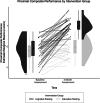Higher white matter hyperintensity load adversely affects pre-post proximal cognitive training performance in healthy older adults
- PMID: 35278154
- PMCID: PMC9213634
- DOI: 10.1007/s11357-022-00538-y
Higher white matter hyperintensity load adversely affects pre-post proximal cognitive training performance in healthy older adults
Abstract
Cognitive training has shown promise for improving cognition in older adults. Age-related neuroanatomical changes may affect cognitive training outcomes. White matter hyperintensities are one common brain change in aging reflecting decreased white matter integrity. The current study assessed (1) proximal cognitive training performance following a 3-month randomized control trial and (2) the contribution of baseline whole-brain white matter hyperintensity load, or total lesion volume (TLV), on pre-post proximal training change. Sixty-two healthy older adults were randomized to either adaptive cognitive training or educational training control interventions. Repeated-measures analysis of covariance revealed two-way group × time interactions such that those assigned cognitive training demonstrated greater improvement on proximal composite (total training composite) and sub-composite (processing speed training composite, working memory training composite) measures compared to education training counterparts. Multiple linear regression showed higher baseline TLV associated with lower pre-post change on processing speed training sub-composite (β = -0.19, p = 0.04), but not other composite measures. These findings demonstrate the utility of cognitive training for improving post-intervention proximal performance in older adults. Additionally, pre-post proximal processing speed training change appears to be particularly sensitive to white matter hyperintensity load versus working memory training change. These data suggest that TLV may serve as an important factor for consideration when planning processing speed-based cognitive training interventions for remediation of cognitive decline in older adults.
Keywords: Cognitive aging; Cognitive training; Processing speed; Total lesion volume; White matter hyperintensities.
© 2022. The Author(s), under exclusive licence to American Aging Association.
Conflict of interest statement
The authors declare no competing interests.
Figures





References
-
- Mewborn CM, Lindbergh CA, Stephen Miller L. Cognitive interventions for cognitively healthy, mildly impaired, and mixed samples of older adults: A systematic review and meta-analysis of randomized-controlled trials. Neuropsychol Rev. 2017;27(4):403-39. 10.1007/s11065-017-9350-8 - PubMed
Publication types
MeSH terms
Grants and funding
LinkOut - more resources
Full Text Sources
Medical

